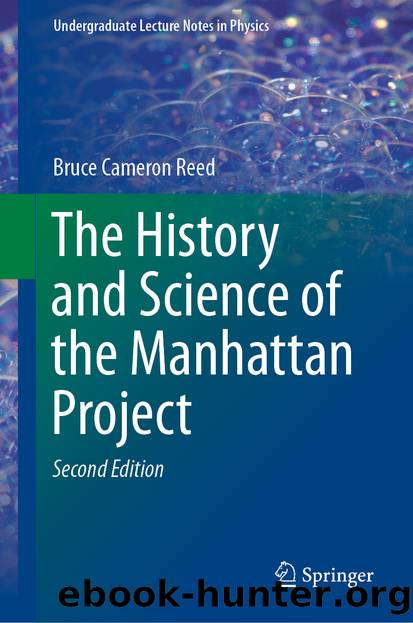The History and Science of the Manhattan Project by Bruce Cameron Reed

Author:Bruce Cameron Reed
Language: eng
Format: epub
ISBN: 9783662581759
Publisher: Springer Berlin Heidelberg
7.1 Origins of the Laboratory
The idea of a centralized, secure laboratory under government control to coordinate fast-neutron research and bomb design was circulating well before the formal establishment of the Manhattan Engineer District. In the spring of 1942, the OSRD had contracts with no less than nine universities that had accelerators which could be used as neutron sources, but the work lacked overall coordination. Gregory Breit raised the issue of a centralized laboratory when he resigned from the project in May, 1942. A month later, Vannevar Bush and James Conant suggested in their report to Vice-President Wallace, Secretary of War Stimson, and General Marshall that a special committee take charge of all research and development on military uses of fissionable material. Immediately after the Bohemian Grove planning session described in Chap. 4, Oppenheimer , Fermi, Lawrence, Compton, Edwin McMillan , and others met in Chicago from September 19–23, 1942, to consider the notion of a bomb-design laboratory . These various ideas became realized as Los Alamos and the Military Policy Committee (Sect. 4.10).
When General Groves was assigned to the project in September, 1942, his letter of appointment made no mention of a design laboratory. Groves began his new assignment with a familiarization tour of project sites, and he met Robert Oppenheimer for the first time in Berkeley on October 8, at which time they discussed the concept of a centralized laboratory. Groves approved the idea on October 19, initially thinking that he would locate the facility near the production plants in Tennessee. In Manhattan District lingo, the bomb-design laboratory was known as Project Y .
Given Compton’s involvement with the Project, his own University of Chicago Metallurgical Laboratory might have seemed a logical choice for a design center, or perhaps Ernest Lawrence’s Radiation Laboratory at Berkeley. But Groves decided that the laboratory site would have to be isolated, relatively inaccessible, have a climate that would permit year-round construction and operations, be large enough to accommodate a testing area, and be sufficiently inland to be secure from enemy attack. None of Oak Ridge, Chicago, or Berkeley was sufficiently isolated, and the latter was also too vulnerable to Japanese attack. Groves assigned the problem of locating a site to Major John Dudley of the Corps of Engineers. After speaking with some of the scientists involved, Dudley estimated that a staff of some 265 would need to be accommodated. He investigated various locations in California, Nevada, Utah, Arizona, and New Mexico. One possibility near Los Angeles was rejected by Groves on security grounds, and another near Reno, Nevada, was discounted on the basis that heavy snowfalls would interfere with winter operations. Oak City, Utah, looked favorable, but would have required evicting several dozen families and taking a large amount of farm acreage out of production. The choices narrowed to two sites north of Albuquerque, New Mexico: one about 50 miles north of the city in the Jemez Springs area, and another about 25 miles northeast of Jemez near Los Alamos. “Jemez” is the Indian name for “Place of the Boiling Springs,” and Los Alamos means “the poplars.
Download
This site does not store any files on its server. We only index and link to content provided by other sites. Please contact the content providers to delete copyright contents if any and email us, we'll remove relevant links or contents immediately.
| Atomic & Nuclear Physics | Particle Physics |
The Complete Stick Figure Physics Tutorials by Allen Sarah(6632)
Secrets of Antigravity Propulsion: Tesla, UFOs, and Classified Aerospace Technology by Ph.D. Paul A. Laviolette(3432)
Thing Explainer by Randall Munroe(3319)
The River of Consciousness by Oliver Sacks(2989)
The Order of Time by Carlo Rovelli(2708)
I Live in the Future & Here's How It Works by Nick Bilton(2520)
A Brief History of Time by Stephen Hawking(2471)
How To by Randall Munroe(2466)
The Great Unknown by Marcus du Sautoy(2180)
What If?: Serious Scientific Answers to Absurd Hypothetical Questions by Randall Munroe(2166)
Blockchain: Ultimate Step By Step Guide To Understanding Blockchain Technology, Bitcoin Creation, and the future of Money (Novice to Expert) by Keizer Söze(2134)
Midnight in Chernobyl by Adam Higginbotham(2075)
Networks: An Introduction by Newman Mark(1994)
The Meaning of it All by Richard Feynman(1905)
Easy Electronics by Charles Platt(1859)
The Tao of Physics by Fritjof Capra(1842)
When by Daniel H Pink(1771)
Midnight in Chernobyl: The Untold Story of the World's Greatest Nuclear Disaster by Adam Higginbotham(1770)
Introducing Relativity by Bruce Bassett(1751)
